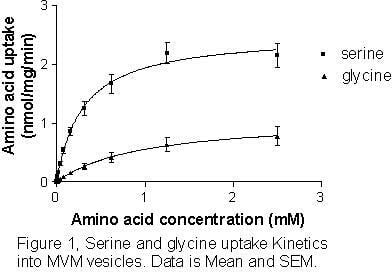On a molar basis, the human fetus requires more glycine than any other amino acid but direct placental transfer of glycine is not thought sufficient to meet fetal demand (Widdowson et al. 1979). L-Serine is a major metabolic source of glycine for the fetal sheep (Chung et al. 1998) and this may also be true in human pregnancy. We have characterised the amino acid transport systems involved in the uptake of serine by the microvillous membrane of the human placental syncytiotrophoblast and compared the uptake rates to those of glycine. Term placentas were collected within 30 min of delivery from women who had provided written informed consent. Using standard techniques (3,4), we prepared microvillous membrane (MVM) vesicles and measured uptakes of 14C-L-serine and 3H-glycine into these vesicles at room temperature. L-Serine uptakes were performed for 15 s (characterisation) or 20 s (kinetics) and glycine uptakes were performed for 60 s, times when uptake had been shown to be linear. Na+-dependent uptake accounted for 40 ± 4% (mean ± SEM, n=14) of L-serine uptake, of which 29 ± 10% was attributable to system A (MeAIB inhibitable). Na+-independent uptake accounted for 60 ± 3% of L-serine uptake, of which 51 ± 3% was attributable to system L (BCH inhibitable). BCH inhibitable L-serine uptake was inhibited by 1 mM L-alanine, L-threonine and L-asparagine, which are substrates of LAT 2, but not LAT 1 or LAT 3, suggesting that the uptake is mediated by the LAT 2 isoform of system L. Uptake kinetics were determined for L-serine and glycine (see figure 1) and analysed using SimFit ver. 5.5 (www.simfit.man.ac.uk). Uptake of L-serine into MVM vesicles had a Vmax of 2.47 ± 0.20 nmol/mg/min and had a Km of 290 ± 20 μM (mean ± SEM, n=3). Uptake of glycine into MVM vesicles had a Vmax of 0.69 ± 0.24 nmol/mg/min and a Km of 210 ± 32 μM (mean ± SEM, n=4). This indicates that MVM vesicles have a higher uptake capacity for L-serine than for glycine. This study indicates that MVM placental uptake capacity for L-serine is substantially greater than for glycine, and that this serine uptake is primarily mediated by system L and system A. If placental transfer, as well as uptake, of L-serine is also greater than for glycine then fetal conversion of serine to glycine may be a significant source of fetal glycine.
King's College London (2005) J Physiol 565P, C160
Communications: Characterisation of serine uptake into microvillous membrane vesicles of the human placenta
Lewis, Rohan Murray; Glazier, Jo D; Greenwood, Sue L; Sibley, Colin P; Godfrey, Keith M; Cameron, Iain T; Hanson, Mark A;
1. DOHaD Centre, University of Southamton, Southampton, United Kingdom. 2. Academic Unit of Child Health, University of Manchester, Manchester, United Kingdom.
View other abstracts by:
Where applicable, experiments conform with Society ethical requirements.

